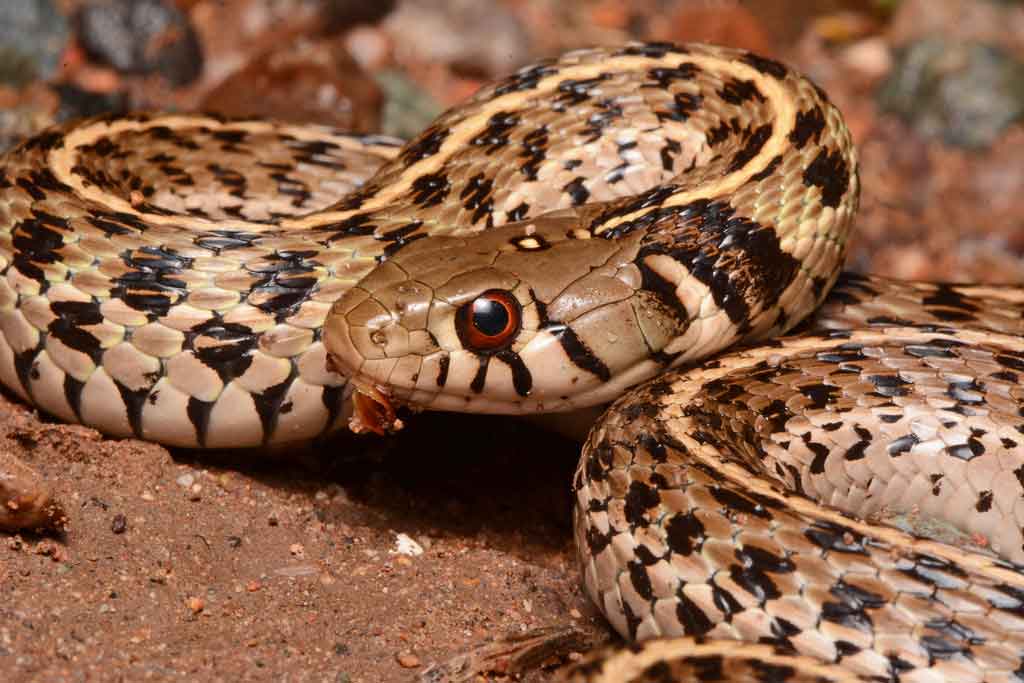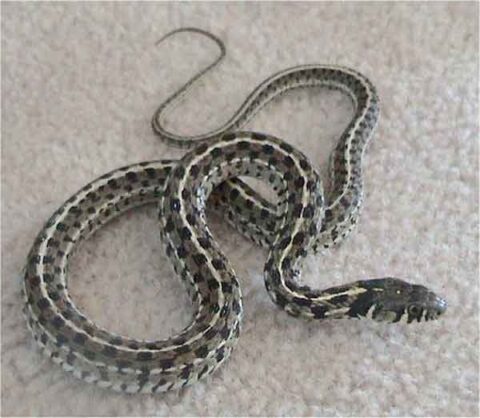
Content |
|---|
Origin / Distribution
The Checkered garter snake (Thamnophis marcianus) is commonly found in the United States, Mexico and some parts of Central America. In United States, are found in Southwestern California, southwestern Arizona and southern New Mexico. In Mexico, have been found as disjoint populations along the Rio Grande, Veracruz, Juchitán de Zaragoza, Tabasco and the center of the Yucatan Peninsula. In Central America, have been found in Tegucigalpa, Honduras; Lake Nicaragua and Managua, Nicaragua; northeastern Costa Rica; The Estrus, Guatemala and Orange Walk, Belice.
Characteristics / Appearance
The Checkered garter snake it gets its common name from the checkered pattern of light black and gray spots along its body.. Both females and males have the same pattern. They have pale yellow stripes along their spines and sides, while its ventral sides are cream-colored. Their heads are olive green with a single thick black line on the neck.. Your body may be gray, brown, oliva, tanned or albino. They have 21 rows of keel-shaped dorsal scales.
Adults weigh an average of 60 g, but they can come to weigh between 31 and 122 g. Adults, can measure between 45 and 106 cm., but the average for adults is 55 cm. (including the queue). The average length of the tail is 16 cm.. The tip of the tongue is black and the rest is a deep red. On the head they have a pale yellow crescent in front of the neck. The females of the Checkered garter snake are bulkier and longer than males, that are thinner and shorter. Females measure an average of 82 cm and weigh 81 g, while males measure 51 cm and weigh 51 g.
The Checkered garter snake measured between 15 and 20 cm. (including the queue) at birth. Juveniles have the same checkerboard patterns as adults.
Habitat
The Checkered garter snake it inhabits areas ranging from sea level to elevations of 2.200 m. It can be found in a variety of habitats ranging from wetlands. (for example, humid tropical forests) to the drylands (deserts and dry forests). They are located in or near water sources such as rivers, ponds, Springs, ditches and lakes. When they are in the grasslands, tend to dig under rocks, logs and thick vegetation. They can also be found in courtyards and gardens. Their populations are shifting westward, traveling along irrigation canals.
From November to the end of February, hibernates at a temperature between 10 and 15° C.
Mating takes place between March and April. From June to August you can give birth to more than 30 live offspring.
Behavior
This species has a calm character. When the Checkered garter snake feels threatened, usually flees. If escape is not possible, defend themselves by threatening and, if that doesn't work, Biting. A last defensive technique that can be used by the Checkered garter snake is emptying your glands and often defecating at the same time. This releases a very unpleasant smell.
Reproduction
The Checkered garter snake begins mating in spring – as soon as it comes out of hibernation at the end of March- until the beginning of April. When it's time to mate, females stop eating and groups of males emit strong pheromones so that females can find them. Once a female has mated, her partner goes to find another female to inseminate her. Females also have the ability to store sperm.
In the North, mating occurs in burrows, where temperatures are warmer; temperatures below 10 °C may cause death or neurological disorders. In the South, when temperatures are 15 at 30°C, reproduction is usually more successful. When they finish mating, females can store sperm or fertilize immediately after mating. Its gestation period is normally 80 to 105 days. Females give birth to a clutch from between 6 and 35 offspring between the months of July and September. Ford and Karges (1987) studied cage snakes in south Texas and northeastern Mexico, and hypothesized that some females may have two clutches a year.. Although they do not support it directly, his anecdotal evidence was the discovery of hatchlings “fully grown” in two moments of the season: April and September.
Males reach sexual maturity at 1,5 years, while females do it to the 2 years. As soon as they are born they are already independent. At birth, the Checkered garter snake weighs an average of 13 g.
The males of the Checkered garter snake have no parental involvement beyond the act of insemination. Females carry and protect their young in their body until they are born. Once born mothers do not provide more parental care.
Food
Diet Checkered garter snake consists of a wide variety of animals, like worms, mice, fish, lizards, slugs, amphibians and eggs. Types of amphibians they eat include tadpoles, adult frogs and salamanders. They hunt small prey in ditches and streams using smell and sight. When kept in captivity, eat thawed mice or other snakes.
Threats to the species
State of conservation ⓘ |
||
|---|---|---|
 Minor Concern ⓘ
(UICN)ⓘ
Minor Concern ⓘ
(UICN)ⓘ
| ||
The Checkered garter snake It is classified as a species of “Least concern” on the IUCN Red list. They do not have special status on the U.S. federal list, in CITES or on the State of Michigan's list.
Most of the populations of the Checkered garter snake throughout their range are stable, but a few disjoint populations in Mexico could be threatened. Several emerging threats include excessive use of pesticides (that can eliminate prey species or bioaccumulate in snakes), the loss of amphibious prey in Mexico and habitat loss.
In some cases, the Checkered garter snake already inhabits protected land (for example, national parks) and there are captive breeding colonies in Mexico. They are also somewhat common in the pet trade., because they are easy to keep in captivity and quite docile. It is believed that the Checkered garter snake is increasing its range following irrigation ditches (in correlation with the expansion of agricultural practices).
The "Checkered garter snake" in captivity

The Checkered garter snake is active throughout the day. This species is usually more active than most domestic snakes.. During the coolest hours of the day they travel their territory in search of food.
The terrarium
Diet
You can choose between offering live or dead prey. It is advisable to offer dead food. This is more practical and prevents the animal that serves as your food from harming your snake.. It also, it is recommended to offer the food with a clamp and do it outside the enclosure. This ensures that her hand is not exposed as food and prevents it from clinging to your hand while you feed it.. If you choose to feed it with live food, you should watch while feeding it. This is because two snakes that have the same prey can injure each other and, sometimes, even eating each other. The ideal prey is as wide as the widest part of the snake.
Cleaning
A hygienic living environment is important to maintain the health of your Checkered garter snake. As such, it is necessary to clean the enclosure regularly. Cleaning once a week is enough. To prevent the accumulation of bacteria, you have to clean and disinfect the entire terrarium a couple of times a year.
Management
This variety has a calm character and is usually easy to handle. But, you have to take into account some things when handling it. Never squeeze the Checkered garter snake when handling it, as the rotating links are fragile and can break easily. It is best to let the snake rest comfortably in the hand. Also make sure your hands are washed and don't smell like food..
Buy one "Checkered garter snake"
When buying, preferably choose young offspring. Animals caught in the wild are usually infected with parasites (internal and/or external), are habitual carriers of diseases and are very sensitive to stress.
Its price in the exotic animal market ranges from 50 – 100 EUR.
Videos "Checkered garter snake"
|
|
|
|---|
Alternative names:
1. Checkered garter snake (English).
2. Serpent jarretière à damier (French).
3. Karierte Strumpfbandnatter, Bunte Strumpfbandnatter, Schachbrettnatter (German).
4. Cobra-liga quadriculada, Serpente de liga quadriculada (Portuguese).
5. "Culebra listonada manchada", Sochuate, Culebra de agua, Culebra Jarretera Ajedrezada (español).
